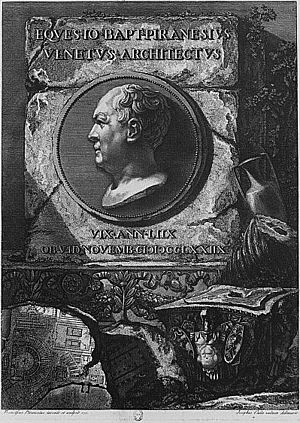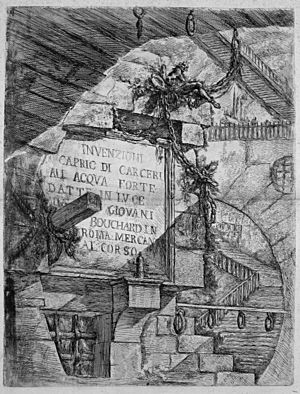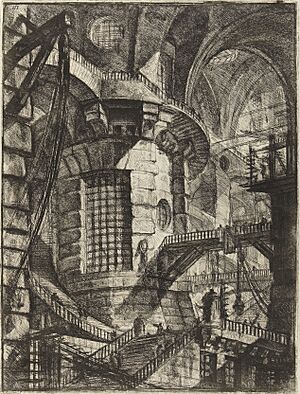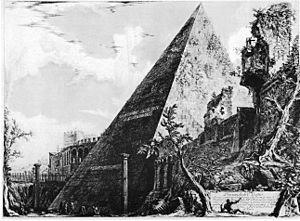Giovanni Battista Piranesi facts for kids
Quick facts for kids
Piranesi
|
|
|---|---|

Portrait by Francesco Piranesi
|
|
| Born | 4 October 1720 |
| Died | 9 November 1778 (aged 58) |
| Education | Matteo Lucchesi |
| Known for | Etching |
|
Notable work
|
Le Carceri d'Invenzione and etchings of Rome |
| Movement | Neoclassicism |
Giovanni Battista Piranesi (born October 4, 1720 – died November 9, 1778) was a famous Italian artist. He was known for his amazing etchings of Rome and its ancient buildings. He also created imaginary, dream-like pictures of huge prisons. People often just called him Piranesi.
Contents
Piranesi's Life Story
Piranesi was born in Venice, Italy. His father was a stonemason, a person who works with stone. His brother, Andrea, taught him about old Roman and Greek history and writings. Later, Piranesi learned from his uncle, Matteo Lucchesi, who was an important architect.
Starting in Rome
In 1740, Piranesi moved to Rome. He worked as a draughtsman (someone who makes detailed drawings) for the Venetian ambassador. While in Rome, he studied with Giuseppe Vasi, an expert in etching and engraving. Etching is a way of making prints by drawing on a metal plate with acid. Engraving is similar, but you carve lines directly into the plate.
Vasi quickly saw that Piranesi was very talented. He even told Piranesi that he was "too much of a painter" to be just an engraver, meaning his artistic vision was too big.
After learning from Vasi, Piranesi worked with other artists to create "vedute" (pronounced veh-DOO-tay). These were detailed views of the city. His first major work was Prima parte di Architettura e Prospettive (1743), which showed architecture and perspectives.
Becoming Famous
From 1743 to 1747, Piranesi spent time in Venice. Some say he visited Giovanni Battista Tiepolo, another famous artist. Tiepolo helped Piranesi think beyond simple drawings of places.
Piranesi then returned to Rome and opened his own workshop. Between 1748 and 1774, he created many more vedute of Rome. These pictures made him very famous. He also spent time measuring ancient buildings. This led to his book Le Antichità Romane, about Roman ancient times.
In 1761, he became a member of the Accademia di San Luca, an important art academy. He also started his own printing house.
Architectural Work
In 1764, Piranesi got his only architectural job. Pope Clement XIII's nephew asked him to restore a church called Santa Maria del Priorato. This church was on Rome's Aventine Hill. Piranesi used his unique imagination to combine old Roman styles with new designs for the church's front and nearby walls.
In 1767, he was made a "knight," which allowed him to sign his name as "Cav[aliere] Piranesi." He also designed interesting fireplaces and furniture. In 1776, he created the famous Piranesi Vase, a large decorated vase.
Piranesi died in Rome in 1778 after a long illness. He was buried in the church he helped restore, Santa Maria del Priorato.
The Views (Vedute)

During the 1700s, many wealthy people from Europe went on a "Grand Tour" to Italy. Rome became a very popular place for artists and travelers. They wanted to see the ancient ruins and new discoveries like those at Herculaneum and Pompeii.
Piranesi loved the ancient ruins of Rome. He didn't just see them as old buildings. He saw their beauty and history. He was very skilled at making etchings that looked real. He could also imagine and add missing parts of the buildings. He used light and shadow to make his pictures dramatic and powerful.
Showing the Past
Piranesi's Views often showed human figures who looked poor or tired. This was a way to show that even great things, like the Roman Empire, can decay over time. It reminded people that nothing lasts forever.
His work greatly influenced a new art style called Neoclassicism. This style looked back to the art and architecture of ancient Greece and Rome. Piranesi's detailed and imaginative pictures of ruins helped people appreciate the past in a new way. He believed that Romans had improved upon Greek ideas. He famously said, "by messing about, one discovers," meaning that experimenting can lead to new ideas.
Many people on the Grand Tour collected Piranesi's prints. The Lobkowicz Collections in Prague still have many of his engravings today.
The Prisons (Carceri)
One of Piranesi's most famous and unusual series of prints is called Carceri d'invenzione, or 'Imaginary Prisons'. These are 16 pictures that show enormous underground rooms with many stairs and strange, giant machines.
He started this series around 1745. The first versions, published in 1750, looked like quick sketches. Later, in 1761, he reworked all the etchings. He added more details and made them even more dramatic. Some of the later prints even show impossible shapes, like stairs that lead nowhere. These "Prisons" are very imaginative and make you feel like you're in a strange, dream-like world.
Piranesi as an Archaeologist
Piranesi was also important as an archaeologist, even though he is mostly known as an artist. He was even chosen to be a member of the Society of Antiquaries of London.
He made very detailed technical drawings of ancient monuments. Many old buildings in Rome were just left in fields and gardens. Piranesi used his engravings to help preserve how they looked. He worked hard to make his pictures very realistic.
Today, many of the monuments Piranesi drew have disappeared or been changed. His precise drawings help us see what Rome was like in the 1700s. He helped share important information about ancient Rome through his beautiful and detailed images.
See also
 In Spanish: Giovanni Battista Piranesi para niños
In Spanish: Giovanni Battista Piranesi para niños





